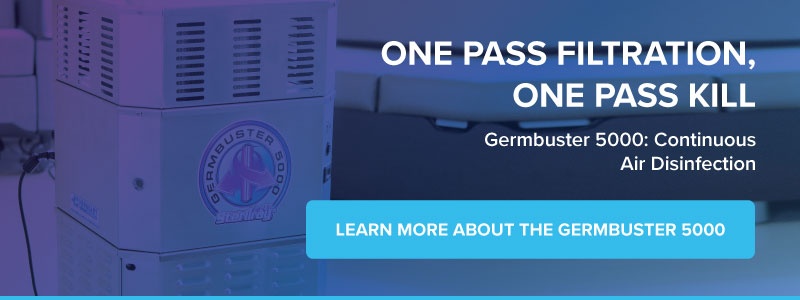Share this
4 Ways to Combat Building-Related Illness and Sick Building Syndrome
by HEPACART on Jan 15, 2020
Sick building syndrome, also known as building-related illness, can be linked to indoor air pollutants.
For decades, sick building syndrome has referred to a group of disorders collectively experienced by certain occupants of a building, with symptoms disappearing once they leave the building. Congress mandated in 1986 that the EPA begin doing research on indoor air quality, and that year the World Health Organization coined the familiar term, estimating that between 10-30% of new office buildings were "sick."
To differentiate between sick building syndrome (for which causes are hard to pin down) and diagnosed illnesses with a proven link to indoor air pollutants, such as asthma attacks caused by high formaldehyde concentrations, researchers called the latter "building-related illness."
Same problems, updated terminology
After backlash arose against labeling buildings with sick building syndrome, researchers adopted a more accurate, but less memorable term, nonspecific building-related illness, to describe building-related symptoms not linked to a specific cause. For illnesses with proven a link to some indoor air pollutants, the term was updated to specific building-related illness.
This may seem like toying with semantics, but using proper terminology helps clarify thinking. While we know how to treat specific illnesses with a diagnosed cause, the problem of nonspecific building-related illnesses must be approached holistically, from treatment of symptoms to a thorough review of ways to improve the indoor working environment.
Specific building-related illness
Both specific and non-specific building-related illnesses occur in modern, air-tight, energy-efficient buildings dependent on HVAC systems rather than open windows for circulation of air. Building occupants can be exposed to pathogens breeding inside poorly maintained air conditioning ducts (fungal spores, viruses, bacteria), as well as to building materials that emit volatile organic compounds (VOCs) such as formaldehyde and acetic acid from plywood, particleboard, carpeting and wallboard, and to fumes from cleaning products and copier chemicals.
Illnesses caused or aggravated by specific indoor pollutants include:
- Legionella infection
- Occupational asthma
- Hypersensitivity pneumonitis
- Inhalational fever
Nonspecific building-related illness
Symptoms of what many still call sick building syndrome include sniffles, stuffy noses, nosebleeds, itchy eyes, scratchy throats, headaches, nausea, dry skin, and fatigue.
A 2016 article in Occupational Health & Safety magazine by Nikki Heinkel summed up what facility managers should look for:

Adding to the difficulty nailing down a cause, according to the CDC's Guide to Indoor Air Quality, is the fact that polluted indoor air is not the only thing that might be making people feel lousy. Other environmental factors come into play, such as poor lighting, noise, vibration, thermal discomfort, and psychological stress. A case in point is the modern-day scourge of open-plan office design, which is known to decrease productivity and increase stress. So, solutions to nonspecific building-related illness are elusive at best.
Solving the problem of building-related illness, whether specific or nonspecific, involves some mix of the following steps:
1. Reducing exposure
2. Treating symptoms
3. Removing the source of pollution
4. Improving ventilation
1. Reducing exposure
When faced with sneezing, headaches, shortness of breath, or other symptoms that disappear outside the building, sufferers should band together, meet with management, and collectively tell leadership about the situation.
A facility manager may wonder if testing the air for pollutants is a reasonable first step, but according to Building-Related Illnesses by Abigail R. Lara, MD (2018), sampling to detect airborne organisms can be costly and time-consuming. In some cases, though, it is necessary to find out what specific pollutants are contaminating the air.
The afflicted employee should also attempt to implement survival strategies such as:
- Take regular breaks outside
- Don't eat lunch at your desk
- Open windows if possible
- Go for a walk every half hour
If all else fails, unfortunately, there is always finding a new job. Though extreme, this measure has the benefit of removing other causes of distress, such as poor temperature control, bad lighting, noise, and inadequate privacy.
2. Treating symptoms
Nonspecific building-related illness is diagnosed by process of elimination. The doctor encourages the patient to keep a journal for recording symptoms so that conditions such as a cold, asthma, and allergies can be ruled out.
Allergy medicines such as Benadryl and Zyrtec are over-the-counter solutions to eye, nose, and skin irritation, while asthma medicines and inhalers may be prescribed for breathing issues.
Treating symptoms should be considered a stopgap measure, of course, as the facility manager tracks down and corrects possible causes within the indoor environment, such as inadequate air circulation, pollutants, poor lighting, and noise.
3. Removing the pollutant
The EPA describes indoor air quality investigation as a "cycle of information gathering, hypothesis formation, and hypothesis testing" that begins with a walkthrough inspection.
Prime suspects are poorly maintained HVAC systems, water-soaked ceiling tiles or carpeting, improper storage or use of pesticides, paints, adhesives and solvents, fumes from copier supplies and (even in this day and age) smoking.
- Besides correcting those problems, the facility manager should consider:
- Vacuuming on a more consistent basis to remove dust
- Making sure humidity is in the 40-70% range
- Getting tested for indoor mold
Modern technology can be part of the solution as well. In cases where pathogens in the air are a primary issue, a portable air scrubber such as the Germbuster 5000 may be used. This machine provides continuous air disinfection using Far-UV light that destroys 99.99% of pathogens in air that passes through it.
4. Improving ventilation
According to the EPA and others, the simplest and most cost-effective way to improve indoor air quality is to increase ventilation rates and air distribution to ASHRAE Standard 62 if possible. The Nation Institute for Occupational Safety and Health (NIOSH) studied 446 buildings with poor air quality and determined that 52% of the problems were due to inadequate ventilation.
The first step for the facility manager should be establishing or reinforcing good HVAC system maintenance procedures. Then, make sure the system's design is adequate to provide the appropriate number of air changes per hour (ACH). Public waiting rooms may require as few as 4 ACH while manufacturing facilities could require anywhere from 10 to 50 ACH.
In some areas of the building, the most efficient solution to stagnant air could be to add high-volume, low-speed (HVLS) fans, otherwise known as ceiling fans.
Finally, far-UV pathogen destruction may be deployed in large scale by adding Far-UV Sterilray™ lamps to building HVAC systems as an effective way to eliminate circulating mold spores or other infectious microorganisms.
Conclusion
Indoor air quality and illness related to it is a complex subject that must be understood and addressed by building occupants, facility managers, and healthcare workers. We encourage you to explore the resources below for a more in-depth understanding of the subject.
- Building Related Illnesses (Merck Manual)
- Sick Building Syndrome Fact Sheet (EPA)
- Sick Building Syndrome and Building Related Illness - What's the Difference? (Healthy Building Science)
- Indoor Air Quality (OSHA)
- The Inside Story: A Guide to Indoor Air Quality (Consumer Product Safety Commission)
- Building Air Quality: a Guide for Building Owners and Facility Managers (EPA)
- Indoor Air Quality FAQ (OSHA)
- Sick Building Syndrome: What It Is and Tips for Prevention (Occupational Health & Safety Magazine)
- An Office Building Occupants Guide to Indoor Air Quality (EPA)


